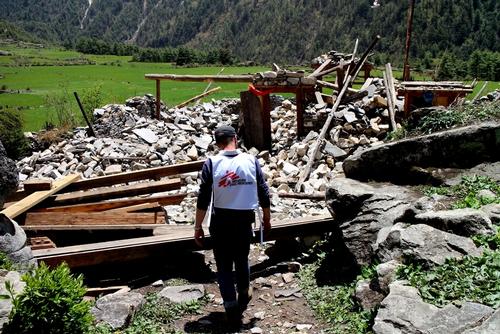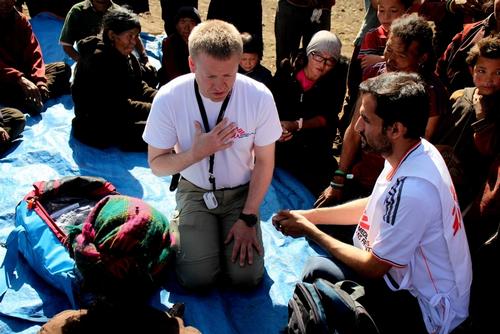Since 29 April, Médecins Sans Frontières (MSF) medical teams in Nepal have started reaching people, spread across isolated mountain villages, by helicopter and on foot. The districts of Dhading, Gorkha, Rasuwa and Sindhupalchowk were hit hard on 25 April by a 7.8 magnitude earthquake, and little or no assistance has reached many villages.
While the most critically injured people were evacuated in the days immediately after the earthquake, those remaining have been trapped in their villages as roads and walking tracks have been cut off by avalanches and landslides. MSF medical teams are flying by helicopter to assess the needs and provide assistance in these remote villages. From 29 April to 4 May, MSF’s medical teams saw people in more than 15 villages.
On 3 May, an MSF team also set up a temporary clinic in the area of Chhapchet, in Dhading district, and began providing basic healthcare and minor surgical interventions. The team will work to spread the word in the surrounding villages that people can now come to the clinic to receive care. On 4 May, another team landed in Lapubesi in Gorkha district, and will stay for three days to provide medical assistance in the area.
“We are seeing people in need of basic healthcare, as well as a number of people with wounds sustained in the earthquake that have now become infected,” says Anne Kluijtmans, an MSF nurse. “We are cleaning and dressing wounds, as well as distributing antibiotics and pain medication. We have also treated cases of pneumonia, including among children.”

Food, shelter and mental health needs
With many villages completely or partially destroyed, the most significant need is for shelter, while some of the more isolated villages in the mountains are facing shortages of food. MSF teams have started distributing high energy biscuits and blankets in Kyanjin Gumba in Rasuwa district, and in Nampa Golche in Sindhupalchowk district. They have also provided more than 500 shelter kits in Gorkha district. Our teams are continuing to look into effective ways to transport both food and shelter materials into the mountains, where temperatures at the higher altitudes are dropping below zero at night.
MSF staff are also seeing significant mental health needs stemming from the traumatic experience of the earthquake, and are adding mental health workers to the teams to start providing psychological first aid in some of the most affected villages.
Hospital support
MSF assessed the situation in a number of the main hospitals in and around Kathmandu that have been treating injured patients. While hospitals were overwhelmed with patients in the first days after the earthquake, the pressure has reduced significantly and the phase for treating patients with acute trauma has passed. People are now waiting for more minor or follow up surgeries, as well as treatment for regular illnesses. MSF has made donations to some hospitals in the capital. In Kathmandu and Pokhara, the authorities responsible for emergency management have mobilised a unit of local nephrologists to treat crush syndrome cases. This has contributed effectively to saving lives.
An MSF surgical team provided support for three days at the hospital in Bhaktapur, on the outskirts of Kathmandu, in order to help the staff operate on waiting patients. In the town of Arughat, in Gorkha district, MSF is setting up a 20-bed inflatable hospital to initially provide treatment for wounded.
Challenge to reach those in most need
Logistical challenges, including congestion at Kathmandu airport and the fact that the majority of the most affected areas are inaccessible by road, have hampered MSF’s efforts to scale up activities quickly.
“Our priority is to reach people in places where no one else is going and who have not received assistance,” says Dr Prince Mathew, who was one of the first MSF staff members to arrive in the country. “So it has been a huge challenge logistically to get the necessary supplies in through the congested airport, and secure the air transport we need to be able to provide medical assistance and deliver shelter and relief materials to the people in most urgent need.”
MSF now has more than 120 staff members in the country and has flown in more than 80 tonnes of supplies, including the inflatable hospital. In addition to flying supplies into Kathmandu, MSF teams working across the border in Bihar state in India, were able to quickly transport shelter, hygiene and kitchen kits by truck to Gorkha, 200 km northwest of Kathmandu and close to the epicentre of the earthquake.
“We will increase the number of clinics as quickly as possible,” says Dr Mathew. “Our teams also plan to distribute tonnes of shelters, hygiene materials and cooking equipment. With the monsoon season approaching, we’re worried that the window of opportunity to reach people in these areas is rapidly closing.”
On 25 April 2015, a 7.8 magnitude earthquake struck Nepal, with its epicentre in Gorkha district, 200 km northwest of the capital, Kathmandu. As of 30 April, the Government of Nepal reported 5,582 deaths and 11,175 injured. More than 130,000 houses were destroyed and 85,856 houses damaged. The country’s only international airport in Kathmandu is heavily congested due to the arrival of numerous international organisations bringing in aid. Tremors were felt strongly in northern India, where to date a reported 72 people have been killed and 237 injured in the states of Bihar, Uttar Pradesh and West Bengal. Casualties are expected to rise. In Tibet, the death toll currently stands at 17.



